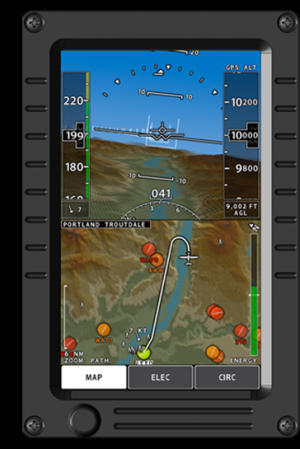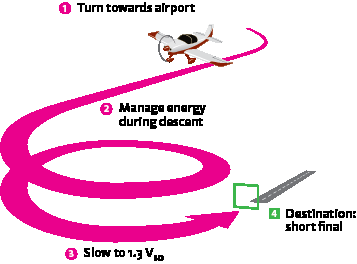The VP-400′s display shows pilots what they need to know to land safely.
You know the routine: Board a flight. Put your seat in the upright position. Tuck away your tray table. Turn off all your portable electronic devices.
Well, here's one electronic device you won't want turned off.
Built using the same Tegra processors found in smart phones, tablets and cars, the Vertical Power VP-400 Runway Seeker can steer a single-engine plane towards a safe landing in the event of an emergency.
All a user has to do to activate it: tug back on the plane's throttle and push a big red button on the device's touch-screen. Then cross your arms and leave the flying to Tegra.
"We're not the first ones to come up with the idea, but we're the first ones to implement it," says Marc Ausman, co-founder and president of the small aviation company that began selling the product in November.
The device is sold as an add-on to the electronic circuit breaker technology Vertical Power sells to small aircraft builders, and is installed in a plane's instrument panel. As the plane flies, the VP-400′s screen shows nearby airports.
Normally, the VP-400 is just a backup electronic flight instrumentation system. When the runway seeker feature is activated, however, the VP-400 taps into the plane's controls via the electronic circuit breaker system.
Once the VP-400′s Runway Seeker is engaged, it manages the plane’s descent, steering it to the nearest runway.
It then steers the plane to the nearest runway if there is an engine failure, bad weather that causes a pilot to lose his orientation or the pilot becomes incapacitated.
White 'highway in the sky' boxes displayed on the screen show the plane's progress.
To make it work, Vertical Power brought together a number of technologies, in addition to the electronics systems it sells to small aircraft builders.
Sophisticated flight simulation software built by X-Plane calculates the effect such factors as the plane's speed and position on all the surfaces of the aircraft.
The VP-400 also relies on databases that describe airports, terrain, and any obstacles that could be encountered.
A Tegra processor on a Colibri T20 module does all the calculations. The Colibri T20 is designed by embedded computing module specialist Toradex, which also supplies the tiny module's Linux-based operating system.
As the plane flies, the Tegra calculates a glide path to every runway within range 30 times a second, taking into account factors such as wind speeds, runway lengths, terrain and potential obstacles.
Once a pilot pushes a button, the path to the nearest airport is locked in.
"For humans to estimate that in the middle of an emergency is very difficult to do, whereas it is relative easy and unemotional for a powerful microprocessor to do," Ausman says.
The result: the plane is guided to what's known as 'short final,' where a pilot is staring the runway in the face and can take over to land the plane.
Provided by NVIDIA























